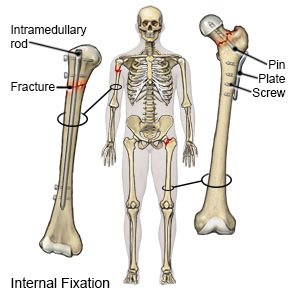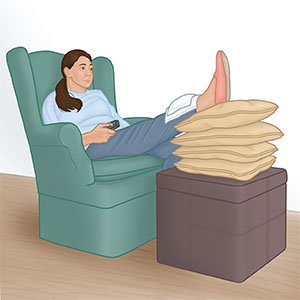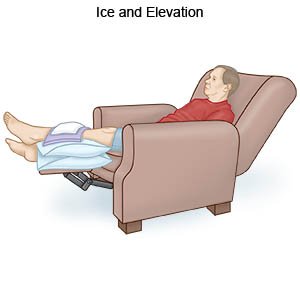ORIF of a Leg Fracture
Medically reviewed by Drugs.com. Last updated on Apr 6, 2025.
AMBULATORY CARE:
What you need to know about open reduction and internal fixation (ORIF) of a leg fracture:
ORIF is surgery to fix a broken bone in your leg. Open reduction means the bone is put back into the correct position. Internal fixation means hardware (such as screws or plates) is used to hold the broken bone together while it heals.
 |
How to prepare for ORIF:
- Your surgeon will tell you how to prepare for surgery. He or she may tell you not to eat or drink anything after midnight on the day of surgery. Arrange to have someone drive you home after surgery.
- Tell your surgeon about all medicines you currently take. He or she will tell you if you need to stop any medicine for surgery, and when to stop. He or she will tell you which medicines to take or not take on the day of surgery.
- Tell your surgeon about all your allergies. Tell him or her if you had an allergic reaction to anesthesia or antibiotics.
What will happen during ORIF:
- An incision will be made in the skin over your broken bone. Your surgeon will put the broken bone pieces back together. Metal pins, screws, rods, or plates will be screwed into the side of the broken bones to hold them together while they heal. Your surgeon may take some bone from your hip. The bone can be used as a graft to help fix and strengthen your broken leg.
- X-rays may be taken during surgery to help your surgeon make sure your broken bone is straight. The x-rays also tell your surgeon if the pins, plates, and screws are placed correctly. Your surgeon may put a hinge called an external fixator on the outside of your broken bone. It will be taken off when your bones have healed. The incision will be closed with stitches or medical tape. A brace or cast will be put on your leg to help hold the bones in the correct position while they heal.
What to expect after ORIF:
You will be taken to a recovery room until you are fully awake. Healthcare providers will watch you closely for any problems. When healthcare providers see that you are okay, you will be taken to your hospital room. Do not get out of bed until your healthcare provider says it is okay.
- A brace or cast will be put on your broken leg after surgery.
- Drains may be put into your skin to remove fluid from your incision wound.
- Medicines may be given to prevent or treat pain, infection, nausea, or a blood clot.
Risks of ORIF for a leg fracture:
After surgery, your leg may not heal correctly. The nerves or blood vessels near the bone may have been damaged when your leg was broken. You may develop a blood clot or a fat embolus (fat that blocks a blood vessel). These problems can be life-threatening.
Call your local emergency number (911 in the US) if:
- You suddenly feel lightheaded and short of breath.
- You have chest pain when you take a deep breath or cough. You may cough up blood.
Seek care immediately if:
- Blood soaks through your bandage.
- Your toes look pale or blue, feel numb, or tingle.
- Your leg feels warm, tender, and painful. It may look swollen and red.
Call your doctor or surgeon if:
- Your cast breaks.
- Your cast gets wet or begins to smell.
- Your bandage or cast feels tighter and you think your toes are more swollen.
- Your cast feels loose.
- You have a lot of itching under your cast.
- You have a fever.
- You have questions or concerns about your condition or care.
Medicines:
You may need any of the following:
- Prescription pain medicine may be given. Ask your healthcare provider how to take this medicine safely. Some prescription pain medicines contain acetaminophen. Do not take other medicines that contain acetaminophen without talking to your healthcare provider. Too much acetaminophen may cause liver damage. Prescription pain medicine may cause constipation. Ask your healthcare provider how to prevent or treat constipation.
- Blood thinners help prevent blood clots. Clots can cause strokes, heart attacks, and death. Many types of blood thinners are available. Your healthcare provider will give you specific instructions for the type you are given. The following are general safety guidelines to follow while you are taking a blood thinner:
- Watch for bleeding and bruising. Watch for bleeding from your gums or nose. Watch for blood in your urine and bowel movements. Use a soft washcloth on your skin, and a soft toothbrush to brush your teeth. This can keep your skin and gums from bleeding. If you shave, use an electric shaver. Do not play contact sports.
- Tell your dentist and other healthcare providers that you take a blood thinner. Wear a bracelet or necklace that says you take this medicine.
- Do not start or stop any other medicines or supplements unless your healthcare provider tells you to. Many medicines and supplements cannot be used with blood thinners.
- Take your blood thinner exactly as prescribed by your healthcare provider. Do not skip a dose or take less than prescribed. Tell your provider right away if you forget to take your blood thinner, or if you take too much.
- Take your medicine as directed. Contact your healthcare provider if you think your medicine is not helping or if you have side effects. Tell your provider if you are allergic to any medicine. Keep a list of the medicines, vitamins, and herbs you take. Include the amounts, and when and why you take them. Bring the list or the pill bottles to follow-up visits. Carry your medicine list with you in case of an emergency.
Self-care:
- Ask about activity. Rest as needed. Do not lift heavy objects. Ask when you can drive, return to your daily activities, and go back to work.
- Use support devices. You may need to use crutches, a cane, or a walker. It is important to use your crutches correctly. Ask your healthcare provider for more information about how to use crutches.
- Ask when you can bathe. When you are allowed to bathe, cover your cast with 2 plastic bags. Tape the bags to your skin above the cast. Keep the cast out of the water so it does not get wet.
- Elevate your leg. Raise your leg above the level of your heart as often as you can. This will help decrease swelling and pain. Prop your leg on pillows or blankets to keep it elevated comfortably.

- Apply ice as directed. Ice helps decrease swelling and pain. Ice may also help prevent tissue damage. Use an ice pack or put crushed ice in a plastic bag. Cover it with a towel and place it on your leg for 15 to 20 minutes every hour as directed.

Go to physical therapy if directed:
A physical therapist teaches you exercises to help improve movement and strength, and to decrease pain.
Follow up with your doctor or surgeon as directed:
You may need to return to have your wound checked and staples or stitches removed. You may also need to have blood tests. Write down your questions so you remember to ask them during your visits.
© Copyright Merative 2025 Information is for End User's use only and may not be sold, redistributed or otherwise used for commercial purposes.
The above information is an educational aid only. It is not intended as medical advice for individual conditions or treatments. Talk to your doctor, nurse or pharmacist before following any medical regimen to see if it is safe and effective for you.
Further information
Always consult your healthcare provider to ensure the information displayed on this page applies to your personal circumstances.
